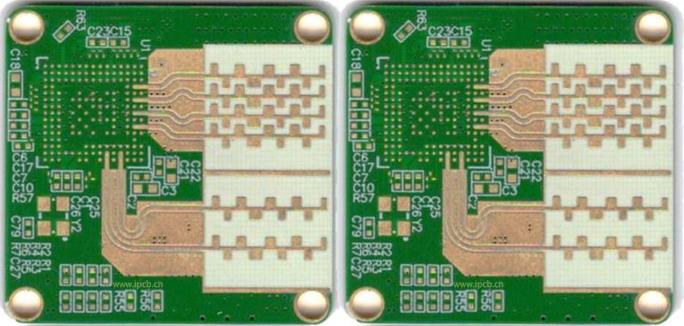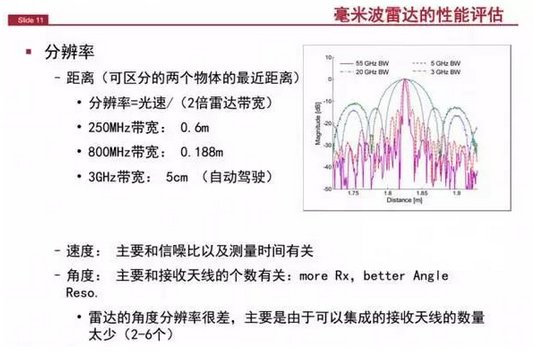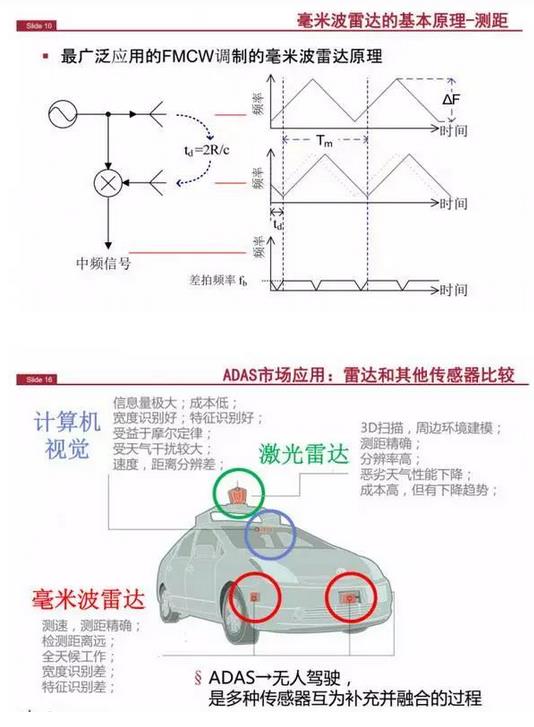In the field of intelligent driving sensors, compared with laser radar, millimetre wave radar is more grounded, and it is technically very mature, and its market shipment is quite considerable. Taking the Chinese market as an example, the sales volume of in-vehicle millimetre wave radar in 2015 was 1.8 million, which is roughly an average of 1 millimetre wave radar for every 12 vehicles. In addition, the penetration rate of millimetre wave radar in Europe is very high.
In the following, we will learn more about in-vehicle millimetre wave radar technology and intelligent driving applications from the aspects of millimetre wave radar frequency bands, development history, basic principles, key technologies and market expectations.
Millimetre Wave Frequency Bands
Millimetre waves are essentially electromagnetic waves. The frequency band of millimetre wave is special, its frequency is higher than that of radio, lower than that of visible light and infrared, and the frequency range is roughly 10GHz-200GHz. millimetre wave is between microwave and THz (1000GHz), which can be said to be a subset of microwave.
In this frequency band, millimetre-wave-related characteristics make it very suitable for applications in the automotive field. Currently, there are three common millimetre wave radar frequency bands for automotive applications.
One is the 24GHz frequency band, which is currently used in a large number of automotive blind spot monitoring and lane changing assistance. The radar is installed in the rear bumper of the vehicle and is used to monitor whether there are cars in the lanes behind the vehicle and whether lane changing is possible.
Another frequency band is 77G circuit board, the frequency of this band is relatively high, the international permitted bandwidth of up to 800 MHz, according to the introduction of Marshal Yuan, the performance of radar in this band is better than 24GHz radar, so it is mainly used to be installed in the front bumper of the vehicle, to detect the distance between the vehicle in front of the vehicle and the speed of the vehicle in front of the vehicle, and to realise the main functions in the field of emergency braking, automatic vehicle following and other active safety.
The third type of application band is 79GHz-81GHz, the biggest feature of this band is its bandwidth is very wide, more than three times higher than the 77G circuit board, which also makes it has a very high resolution, which can reach 5cm. this resolution is very valuable in the field of automatic driving, because the automatic driving car has to distinguish between people and other fine objects, which has very high requirements on the bandwidth. This is very valuable in the field of autonomous driving because autonomous vehicles have to distinguish between many fine objects, such as people, which requires a high frequency.
In terms of wavelength, the wavelength of 24GHz millimetre wave is 1.25cm,while the wavelength of 77GHz millimetre wave is about 4mm.The wavelength of millimetre wave is more than 1,000 times longer than that of the light wave, so it has a stronger penetration ability to the object.
For example,the diameter of the dust we usually see is about 1um-100um,and the diameter of the raindrops in nature is within the range of 0.5mm-4mm.Therefore,electromagnetic waves with wavelengths equal to or longer than these can easily penetrate these obstacles,and millimetre waves have this capability.
This kind of reliability is difficult to be achieved by any other sensors, so in the field of ADAS,which requires high safety and reliability, millimetre wave radar has an unshakeable position.

Millimetre wave radar pcb
History of Millimetre Wave Radar in Vehicular Applications
In fact, millimetre wave radar began to be used in the automotive field in the United States in the 1960s.However,at that time,the technology level was relatively low, and the application was a single antenna with only one receive and one transmitter at the front end, with a frequency of only 10 GHz.
Later,in order to reduce its size,experts in the industry kept raising the frequency to 30 GHz and 50 GHz,and the higher the frequency of the radar, the smaller the antenna size, which meant that the antenna beam of the same size of the radar was more concentrated.
In the 1990s,millimetre wave radars were developed in 60 GHz, 77 GHz circuit boards and 94 GHz.60 GHz was later used mainly for communications, 94 GHz was mainly a military band, and 77 GHz was chosen by the industry as the mainstream millimetre wave radar frequency band.
Historically, there are typical millimetre wave radar applications,in 1992,the U.S. Department of Transportation installed 1,500 sets of millimetre wave radar on Greyhound buses, and achieved immediate results in 1993: traffic accidents decreased by 25%. However, in the end, because the effect is too good,damage to the interests of some vested interests, so in 1994 was completely removed.
Millimetre wave radar for distance,speed and angle detection
To be clear,the performance of millimetre wave radar in measuring distance, speed and angle of a target is slightly different from that of other sensors. Visual sensors get two-dimensional information without depth information, while millimetre-wave radar is equipped with depth information, which can provide the distance of the target; laser radar is not sensitive to speed, while millimetre-wave radar is very sensitive to speed, and the speed of the target can be obtained directly because millimetre-wave radar has a very obvious Doppler effect, and the speed of the target can be extracted through the detection of Doppler frequency shift.
The most basic detection technology of millimetre wave radar is to use FMCW continuous linear FM wave to detect the distance of the object in front of it. Millimetre wave radar emits continuous wave, which is more computationally intensive than that of laser radar in terms of back-end processing.
Here's how it works:
An oscillator generates a signal with a frequency that increases over time. When the signal encounters an obstacle, it bounces back with a delay of 2 times the distance/ speed of light.There is a frequency difference between the returned waveform and the emitted waveform, and this frequency difference is linearly related to the time delay: the further away the object is, the later the returned waveform is received,and the greater the frequency difference between it and the incident waveform.
By subtracting these two frequencies, we can get the difference frequency of the two frequencies (differential beat frequency), and we can judge the distance of the obstacle by judging the level of the differential beat frequency.
Based on this, there are many advanced modulation methods.

Performance of Millimetre Wave Radar
There are also more advanced FM techniques implemented to detect the speed of the target,mainly based on the Doppler shift principle.
Angle detection is achieved by the time delay between signals received by multiple receiving antennas.As a simple example,if there are two antennas receiving an electromagnetic wave from a certain direction, there is a difference in the time it takes for the electromagnetic wave to reach the two antennas, or a phase difference,through which the angle of the signal can be evaluated.
Here we have to introduce a very important concept - the resolution of a millimetre wave radar. Its definition is radar can distinguish between the two objects of the nearest distance’, for example, two objects are very close, then the radar may be listed as an object, if the separation of some, the radar will see two objects. If they are separated, the radar will see both objects. How far away the radar can distinguish the distance between the two objects is called the resolution of the radar.
The formula for calculating the resolution is also very simple, it is the speed of light / 2 times the radar bandwidth,so for 24GHz and 77G circuit boards, the resolution can be calculated directly.For 24GHz and 77G circuit boards, the resolution can be calculated directly, which is 0.6m for the former and 20cm for the latter,while the millimetre wave radar with 3GHz bandwidth can achieve a resolution of 5cm,which is very suitable for automated driving applications.

Millimetre wave radar comparison
Overall, the cost of millimetre-wave radar is falling faster because it is a silicon-based chip and does not have a particularly expensive and complex process.Laser radar, on the other hand, has high requirements for optical transceivers and assembly processes, making it more difficult to bring down the cost.
Another very important technology of laser radar is solid-state laser radar,which is actually the same as traditional radar and millimetre wave radar pcb. Solid-state laser radar actually adjusts the phase of each transmitting and receiving unit, and millimetre-wave radar is also based on the same principle,only that millimetre-wave radar is operated on electromagnetic waves,and it is much more difficult to implement devices than to change the phase of the optical frequency band. It is much less difficult to realise the device than to change the phase in the optical frequency band.
As for the market prospect of millimetre wave radar, a car will carry three vehicles.A car will carry three to eight millimetre wave radars, and seven of them have already been installed in the high-end Mercedes-Benz. In the next 10 years, the market size of in-vehicle millimetre wave radar will not be underestimated.
From the policy point of view,all countries are promoting the AEB function of automobiles,of which Japan and North America are already implementing it, and China will also implement it into the commercial vehicle field in 2018.
Millimetre wave radar is a very difficult sensor to replace in the ADAS field.Although it has some drawbacks,it is the only sensor that can work around the clock. The accuracy of speed and distance measurement is much higher than that of vision, and compared with laser radar,the accuracy of speed measurement will be higher.The penetrating power is better. But overall, this is not a conflict, because the future will move towards the trend of integration, especially for unmanned driving, there is no doubt that the three sensors will be integrated with each other.